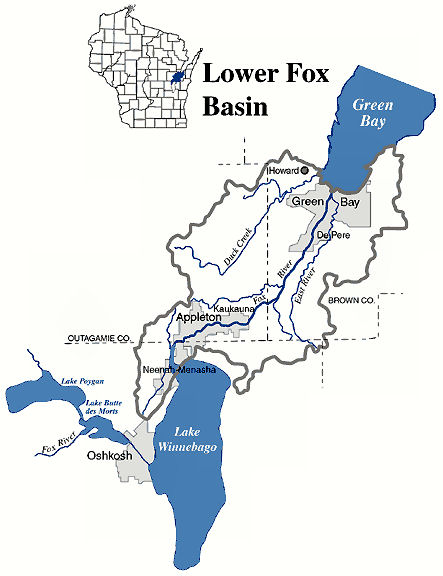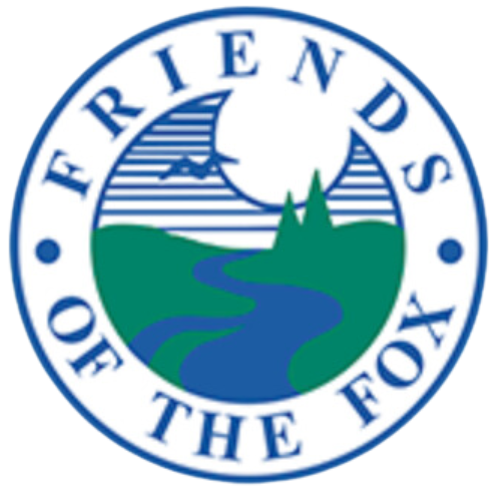PCB’S
The Lower Fox River, located in northeastern Wisconsin, begins at the Menasha and Neenah channels leading from Lake Winnebago and flows northeast for 39 miles where it discharges into Green Bay and Lake Michigan. Approximately 270,000 people live in the communities along the river. The river has 12 dams and includes the highest concentration of pulp and paper mills in the world. During the 1950s and 1960s, these mills routinely used PCBs in their operations which ultimately contaminated the river.

PCBs do not degrade naturally, but instead concentrate in the environment and the food chain resulting in health hazards to humans, fish and wildlife. The Lower Fox River project involves the cleanup of sediment (mud) contaminated with PCBs, as well as the restoration of the natural resources damaged by these contaminants.
A number of federal, state and tribal agencies have joined efforts to address this important issue through regulatory avenues including Superfund, the Natural Resource Damage Assessment, and state spill authorities.
What are PCBs?
As a result of the recycling of PCB-containing carbonless copy paper, area mill operations discharged PCBs in waste streams, contaminating sediment in the Lower Fox River. The Lower Fox River is the largest source of PCBs to Lake Michigan in the basin. From 1957 to 1971, about 250,000 pounds of PCBs were released, contaminating 11 million tons of sediment. It is estimated that some 160,000 pounds of PCBs have already left the Fox River and entered Green Bay and Lake Michigan. On average, 300 to 500 additional pounds are flushed from the Lower Fox sediment each year. Floods would flush additional thousands of pounds into Green Bay. Once PCBs are released into the bay and Lake Michigan, they are extremely difficult, if not impossible, to recover.
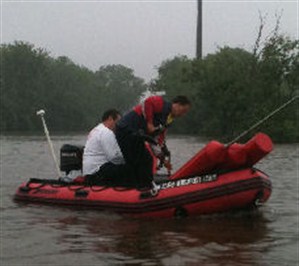
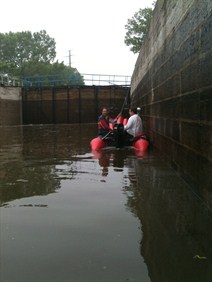
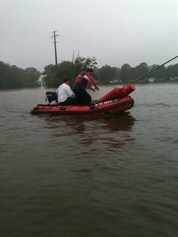
The Fox River/Green Bay Cleanup Project
The Lower Fox River and Green Bay areas experienced both the good and bad sides of economic development. Once described as “the hardest working river in the world” because of the amount of industry that used the waterway, the Fox River now shows the results of past discharges of municipal and industrial byproducts.
Between about 1954 and 1971, paper companies using polychlorinated biphenyls (PCBs) to make carbonless copy paper discharged nearly 700,000 pounds of these chemicals into the Fox River. The dangers posed by PCBs were unknown until the early ´70s, but their use and discharge into the environment were outlawed by federal environmental regulations in 1976. The ban was successful, but because PCBs bind to dirt and break down very slowly, they are still found today in the sediment of the Lower Fox River and Green Bay.
Since the 1970s there have been significant improvements in the water quality in this system. This has resulted in the restoration of a diverse fishery, including a world-class walleye fishery. However, levels of PCBs (and mercury) in fish are still high enough that consumption advisories for most species are needed to protect human health.

Exotic invasive species information
Exotic species are plants or animals that enter an ecosystem from beyond their native ranges.
Exotics are sometimes called “invasive” species because they tend to take over new habitats. That’s because natural predators aren’t present outside the exotics’ normal range. Native species aren’t adapted to exotics, and lack the ability to compete. The population explosion that results can upset the ecological balance of aquatic or terrestrial habitats. Once established, exotics are nearly impossible to eliminate.

VHS prevention in Fox River
We want people to continue to enjoy Wisconsin’s great fishing and boating, but need everyone to do their part. All boaters and anglers should follow some simple precautions to prevent the spread of VHS and other invasive species in Wisconsin waters.
In addition, the following statewide rules apply to boaters, anglers and wild bait harvesters in Wisconsin.
- Boaters and Anglers
- Anglers who harvest wild bait for personal use
- People who harvest wild bait harvest for commercial use
More Information from State of Wisconsin DNR

VHS Virus Explained
The VHS virus has been confirmed in Lake Winnebago and Little Lake Buttes des Morts.
Samples were taken from the Little Lake on May 2nd, 2007 and from Lake Winnebago on May 9th, 2007.

Anglers and Boaters laws on VHS in Wisconsin
The following new laws apply to all anglers and boaters in Wisconsin:
- You must drain all water from boats, containers and fishing equipment when leaving any state waters, banks or shores, or entering Wisconsin over land. This does not apply to any drinking water or up to 2 gallons of water being used to hold minnows that can be legally transported.
- You may not transport any live fish or live fish eggs away from any state waters. There is an exception for minnows obtained from a Wisconsin bait dealer. These minnows may be transported away live and used again:
- On the same water, or
- On any other waters if no lake or river water, or other fish were added to their container.
- You may not use dead fish, fish eggs, or fish parts as bait. There are three exceptions:
- You may use dead fish, fish eggs, or fish parts as bait on any waters if they were preserved by a method that does not require freezing or refrigeration, or
- You may use unpreserved or just frozen dead fish, fish eggs or fish parts as bait on the water from which they were collected or on Lake Michigan or Green Bay (and connecting waters upstream to the first barrier impassible to fish), or
- Live minnows that die during a fishing trip may be used during that fishing trip (they may not be used on later trips unless you meet the two conditions above).
You may not possess or use minnows for bait that are obtained outside of Wisconsin. This does not apply if the minnows were imported under a Wisconsin Department of Agriculture, Trade and Consumer Protection (DATCP) permit, or if they were obtained from Iowa or Minnesota and are being used only “between the tracks” on the Mississippi River.
More Links of Interest
- Fox River Clean-up Project – Nine-year cleanup effort that includes dredging and capping to get rid of PCB’s
- Little Lake Cleanup – This will show you the efforts being made to cleanup Little Lake Butte des Morts, and the areas they will be working on in 2007.
- Fox River Watch – Harms of PCB’s in fish
- Lower Fox Cleanup – Little Lake Cleanup Team

In 2006, the Wisconsin Department of Natural Resources Office of the Great Lakes, with the help of countless individuals and organizations, began developing a Wisconsin specific strategy to parallel the Great Lakes Regional Collaboration Strategy. Called the Wisconsin’s Great Lakes Strategy (Strategy), it brought together information from the various past planning efforts to build a comprehensive state action agenda. The Strategy will serve as the vehicle for coordinating and allocating resources and will better position Wisconsin to begin program and project implementation in the event that significant funding comes from the US Congress for the restoration of the Great Lakes.
Wisconsin’s roadmap for protecting and restoring its Great Lakes natural resources has been updated, and state officials hope it will put Wisconsin in the seat for the $475 million President Barack Obama has proposed for 2010 for Great Lakes ecosystems.
